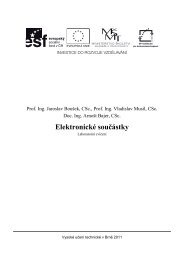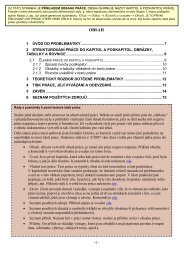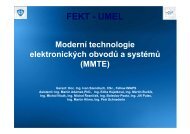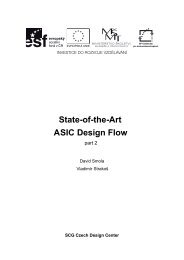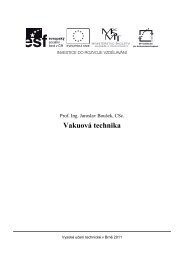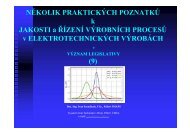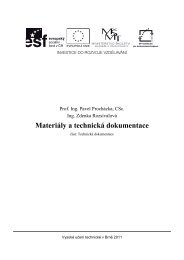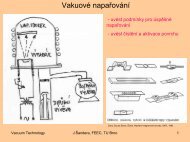Resonant MEMS microsensor for the measurement of fluid ... - UMEL
Resonant MEMS microsensor for the measurement of fluid ... - UMEL
Resonant MEMS microsensor for the measurement of fluid ... - UMEL
- No tags were found...
Create successful ePaper yourself
Turn your PDF publications into a flip-book with our unique Google optimized e-Paper software.
<strong>Resonant</strong> <strong>MEMS</strong> <strong>microsensor</strong><strong>for</strong> <strong>the</strong> <strong>measurement</strong> <strong>of</strong> <strong>fluid</strong> density and viscosityO. Vancauwenberghe 1 , A.R.H. Goodwin 2 , E. Donzier 1 , M. Manrique 2 , and F. Marty 31 Schlumberger Doll Research, 36 Old Quarry Road, Ridgefield CT 06877, USAemail: vanco@slb.com2 Schlumberger Cambridge Research, High Cross Madingley Road, Cambridge CB3 0EL, UK3 Groupe ESIEE, SMM, Cité Descartes, BP 99, F-93162 Noisy-le-Grand, FranceSummary: A resonant <strong>MEMS</strong> <strong>microsensor</strong> was developed to measure <strong>fluid</strong> density and viscosity. Itconsists <strong>of</strong> a thin plate made <strong>of</strong> a SOI top layer vibrating at resonance in its first bending mode. Its workingprinciple is based on <strong>the</strong> resonance frequency and quality factor affected by <strong>the</strong> surrounding <strong>fluid</strong> densityand viscosity. Measurements have been done in a series <strong>of</strong> gases and liquids at different pressures andtemperatures. The resonant <strong>MEMS</strong> is able to measure densities to ± 1% in <strong>the</strong> range <strong>of</strong> 1 to 1100 kg/m 3 andviscosities to ± 5% in <strong>the</strong> range <strong>of</strong> 10 to 10 5 µPa s.Keywords: Density, viscosity, <strong>Resonant</strong> <strong>MEMS</strong>, vibrating plate, SOICategory: 4 (Non-magnetic physical devices)1 IntroductionIn <strong>the</strong> petroleum industry, <strong>measurement</strong>s <strong>of</strong> densityand viscosity are required to determine <strong>the</strong> value <strong>of</strong><strong>the</strong> produced <strong>fluid</strong> and production strategy. Densityand viscosity <strong>measurement</strong>s are also important inindustrial process control, especially in chemicaland food industries.We took advantage <strong>of</strong> <strong>the</strong> fact that <strong>the</strong> vibration<strong>of</strong> a plate is affected by <strong>the</strong> surrounding <strong>fluid</strong> todesign a resonant <strong>MEMS</strong> <strong>microsensor</strong> using SOIwafers and DRIE micromachining. In this paper,we will describe our sensor working principle andfabrication, and report <strong>the</strong> <strong>measurement</strong>s obtained.to control and measure <strong>the</strong> resonance frequency f aswell as <strong>the</strong> amplitude or equivalently <strong>the</strong> qualityfactor Q.Fig. 1. Picture <strong>of</strong> <strong>the</strong> whole Si resonant <strong>MEMS</strong><strong>microsensor</strong> with main components indicated.2 Principle <strong>of</strong> operationThe resonant <strong>MEMS</strong> <strong>microsensor</strong>, shown in Figure1, consists <strong>of</strong> a thin vibrating plate made <strong>of</strong> <strong>the</strong> topsilicon layer <strong>of</strong> a Fusion-Bonded SOI wafer. Theuse <strong>of</strong> SFB SOI wafers allows us to choose at will<strong>the</strong> thickness <strong>of</strong> <strong>the</strong> vibrating plate and simplifies<strong>the</strong> DRIE micro-machining steps by providing anetch stop with <strong>the</strong> buried oxide (BOX).To drive into resonance <strong>the</strong> vibrating plate,magnetic <strong>for</strong>ces are used as illustrated in Figure 2.The device is placed in a constant magnetic field Bgenerated by an external electromagnet or apermanent magnet. With an alternating current Iinjected in a coil fabricated on <strong>the</strong> plate top surface,alternating Laplace <strong>for</strong>ces F put <strong>the</strong> plate in <strong>for</strong>cedoscillations. When <strong>the</strong> current is at <strong>the</strong> plate firstnatural frequency, <strong>the</strong> plate vibrates in resonance inits first bending or flexion mode with maximumamplitude. Piezoresistive gauges configured inWheatstone bridges and placed close to <strong>the</strong>clamped edge are used to sense <strong>the</strong> varying strainsin <strong>the</strong> plate as it oscillates. These bridges allows usFig. 2. Actuation principle by Laplace <strong>for</strong>cesWhen <strong>the</strong> <strong>MEMS</strong> sensor is placed in a given<strong>fluid</strong>, its resonance characteristics, f and Q, will beaffected by <strong>the</strong> surrounding <strong>fluid</strong> as follows. The<strong>fluid</strong> in proximity to <strong>the</strong> oscillating plate is movedby <strong>the</strong> body’s motion, adding effective mass orinertia to <strong>the</strong> intrinsic mass <strong>of</strong> <strong>the</strong> plate, hencedecreasing f. The shearing associated with <strong>the</strong> <strong>fluid</strong>motion around <strong>the</strong> plate gives rise to viscous energyloss per cycle, and so makes Q < Q vacuum . Thus, <strong>the</strong>density ρ and viscosity η <strong>of</strong> <strong>the</strong> <strong>fluid</strong> may beobtained by measuring f and Q <strong>of</strong> <strong>the</strong> vibratingplate in resonance.BFI18
3 <strong>MEMS</strong> fabricationThe starting wafer is a 4” SFB SOI wafer with a topSi layer 20 µm thick. A <strong>the</strong>rmal oxide is firstgrown, <strong>the</strong>n a 0.4 µm PolySi layer is deposited,implanted with boron and patterned to define anRTD <strong>for</strong> temperature in-situ <strong>measurement</strong> and <strong>the</strong>piezoresistive gauges <strong>for</strong> resonance control and fand Q <strong>measurement</strong>s. After passivation and contactopenings, a 1 µm thick aluminum layer is sputterdeposited and patterned to define <strong>the</strong> coil and o<strong>the</strong>rinterconnections.DRIE is <strong>the</strong>n used to etch from <strong>the</strong> front side <strong>the</strong>SOI layer around <strong>the</strong> plate and from <strong>the</strong> back side<strong>the</strong> Si substrate all underneath <strong>the</strong> plate. A final HFetch <strong>of</strong> <strong>the</strong> BOX layer releases <strong>the</strong> vibrating plate.Figure 3 shows a completed resonant <strong>MEMS</strong>sensor in its package specifically designed to allowit to be dipped in various <strong>fluid</strong>s, liquids or gases, atvarious pressures (up to 70 MPa or 10 kpsi) andtemperatures (up to 150 °C).4 MeasurementsFig. 3. <strong>MEMS</strong> in its packageTable 1 shows f and Q measured in vacuum and invarious <strong>fluid</strong>s, namely inert gas (Ar), natural gas(CH 4 ), reservoir oil, <strong>for</strong>mation water, and siliconeoil. In vacuum and at 298 K, f 0 is 5.3 kHz, in goodagreement with FEM simulations with ANSYS.Fluid ρ (kg/m 3 ) η (mPa⋅s) f (Hz) QP → 0 5326 4556CH 4 7.23 0.011 4722 127Ar 671 0.049 1429 60Crude oil 774 1.02 1160 10Brine 1060 0.99 1005 12Si oil 1910 2200 527 2Table 1. f and Q in vacuum and various <strong>fluid</strong>s.With some approximations, simple relations canbe derived to describe <strong>the</strong> dependency <strong>of</strong> f and Q on<strong>the</strong> <strong>fluid</strong> density ρ and viscosity η:ff⎛πwρ= ⎜1+4h ρ⎝0 Si⎞⎟⎠−1232and Q f ηρ = CSTwhere ρ si is <strong>the</strong> Si density, w and h are <strong>the</strong> platewidth and thickness and CST is a constant [1, 2, 3].However, a more elaborate model [3] wasnecessary to account <strong>for</strong> <strong>the</strong> f and Q variations over<strong>the</strong> whole range <strong>of</strong> densities and viscosities <strong>for</strong> bothgases and liquids.To calibrate <strong>the</strong> <strong>microsensor</strong>, three parametersdefined in <strong>the</strong> model need to be adjusted by fitting<strong>the</strong> measures taken with argon. After this ra<strong>the</strong>rsimple calibration, densities in <strong>the</strong> range <strong>of</strong> 1 to1100 kg/m 3 can be measured to ± 1%, andviscosities in <strong>the</strong> range <strong>of</strong> 10 to 10 5 µPa s to ± 5%.These accuracies on ρ and η were obtained bycomparing measured values with ei<strong>the</strong>r acceptedliterature or experimental values.Figures 4 and 5 show <strong>the</strong> error on measureddensities and viscosities <strong>for</strong> Ar, N 2 , CH 4 , heptane,crude oil, <strong>for</strong>mation water and reference standards.10 2 Dr /rh (expt.)/(mPa.s)210-1-2100000Ar 333 KAr 353 KAr 373 KAr 393 KN2 333 Kn-heptane 333 KCrude OilFormation waterVis + den STD0 200 400 600 800 1000 1200r /(kg/m 3 )100001000100Fig. 4. Relative error on measured densities10N2CH4ArHeptaneCrude oilFormation waterVis + den STD10 100 1000 10000 100000h (lit.)/(mPa.s)Fig. 5. Comparison between measured viscosities andreferenced valuesReferences[1] J.E. Sader, “Frequency response <strong>of</strong> cantileverbeams immersed in viscous <strong>fluid</strong>s with applicationsto <strong>the</strong> atomic <strong>for</strong>ce microscope”, J. Applied Physics84 (1998) 64-76, and references <strong>the</strong>rein.[2] L.D. Landau, E.M. Lifshitz, Fluid mechanics,Pergamon (Ox<strong>for</strong>d, 1989).[3] A.R.H. Goodwin, E. Donzier, M. Manrique, O.Vancauwenberghe, to be published.19




